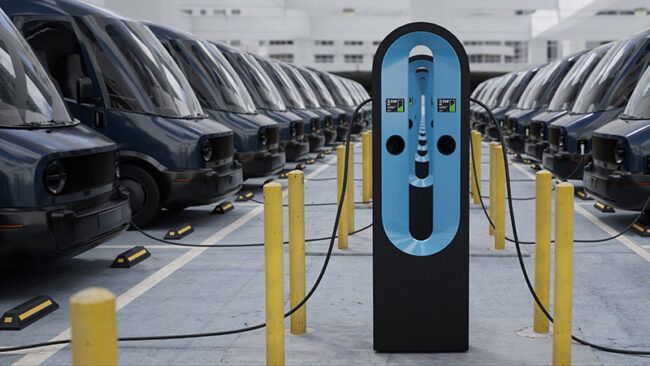Stay connected
Subscribe to our fleet blog and follow us on social media to receive all our fuel and energy industry insights.

In an earlier blog post about transitioning to mixed energy fleets, we shared that according to experts, electric vehicles (EVs) will make up at least a third – or even half – of all light vehicles sold yearly in the United States by 2030. This is up considerably from what was about 7% of all sales in 2022. EV adoption is gaining momentum. That said, there are a lot of common misconceptions in the marketplace about EVs. We want to help break down the misconceptions for you. If you have EV questions, this EV FAQ is for you.
According to AAA, owning a new, compact EV is only slightly more expensive – about $600 annually – than owning a gas-powered counterpart. While the overall annual cost may be more, EVs cost less to own in individual categories such as fuel and maintenance. On the fuel side of things, the electricity required to drive 15,000 miles per year in a compact EV costs an average of $546, while the amount of gas required to drive the same distance costs $1,255 (or 130%) more. As related to maintenance, EVs do not require as much maintenance as gas-powered vehicles since they don’t need oil changes or air filter replacements. If maintained according to the automakers’ recommendations, EVs may cost $330 less annually (on average) than a gas-powered vehicle.
The four main types of EVs are:
The short answer is yes, an EV can be charged at home. EVs can be charged with the 120-volt portable charging cord that’s standard or optional with all new EVs. Another option is to install a Level 2 charging station that operates at 240 volts, which is the same voltage used by electric stoves and clothes dryers.
For organizations with EVs in the United States, WEX offers WEX EV At-Home. WEX EV At-Home is an innovative, cutting-edge solution that automates reporting and reimbursement for any organization with EVs that employees bring to their personal residence to charge overnight, the most cost effective way to charge. When coupled with WEX’s other commercial fleet innovations, including WEX En Route, businesses can seamlessly integrate mixed fleets of electric and traditionally fueled vehicles, supporting a balance of innovation, operational reliability, and efficiency at any stage of a company’s transition to EVs.
“There are few EV solutions that simplify charging for commercial drivers and allow fleet managers access to line item charging detail, vehicle performance, and unified billing regardless of brand — and even fewer regardless of charging location,” said Jay Collins, WEX’s General Manager, Energy Transition. “That WEX’s EV solutions accomplish this – while also integrating with metrics from traditional fuel vehicles across a single credit line, invoice, and backend software portal – is illustrative of WEX’s leadership and technical expertise in the commercial mixed fleet space. WEX’s continued innovation signifies a true commercial mixed fleet experience – offering fleet managers the ability to easily add EVs without sacrificing their needs for security, control and unified reporting all in one place.”
There are two types of public charging: Level 2 stations and DC fast-chargers. Level 2 chargers are similar to at-home chargers; they tend to be slower, making them best for overnight or long-stay parking. DC fast chargers are much quicker and are found along major travel routes. They’re used more like gas stations for gasoline-fueled vehicles.
WEX EV En Route makes it easy to find chargers and offers access to a broad and rapidly growing network of public charging stations in the U.S. Through WEX’s DriverDash app and RFID card, WEX En Route leverages WEX’s proprietary closed loop payments network to increase the security of each transaction and to transmit charging behavior, driver identification information, and vehicle mileage to the fleet manager. WEX’s DriverDash app and RFID are accepted across the U.S. at ChargePoint-branded EV chargers and at ChargePoint’s roaming partner brands, including AmpUp, Blink, EVConnect, EVgo, and FLO.
Cost varies by when and where you charge. Home electricity rates can vary a lot, from 16 to 35 cents per kilowatt-hour (kWh). The U.S. average is now about 16 cents per kWh, and you get roughly three miles for each kWh in an electric car or small SUV and two miles in a large, heavy electric truck. Charging at home at the average price means you spend about $5.30 to go 100 miles in the smaller EV, and $8.00 in an electric truck. When compared to current gasoline and diesel fuel prices, EVs are very economical.
At public fast-charging stations, rates usually vary from 25 to 50 cents per kWh. So, the same 100 miles will now cost $8.00 (for a car or small SUV) to $25.00 (for a truck). Many EV makers, however, provide a certain number of free fast-charging hours during the first two or three years of ownership, making road-trip recharging entirely free for that time.
Making the move from internal combustion vehicles to a mixed-energy fleet that includes electric vehicles can be challenging. The WEX suite of EV solutions helps you decide what vehicles to replace and, as you add EVs to your fleet, allows you to pay for charging and fuel with one credit line and receive integrated reporting and invoicing.
Learn more and get your fleet operations ready for a mixed fleet that makes the most sense for your business.
WEX is a leading, global fintech solutions provider, simplifying payments and back-end business processes in the fleet management, benefits management, and corporate payments areas. To learn more, please visit the company’s About WEX page.
Resources:
AAA
Car and Driver
U.S. Department of Transportation
U.S. Energy Information Administration
Subscribe to our fleet blog and follow us on social media to receive all our fuel and energy industry insights.